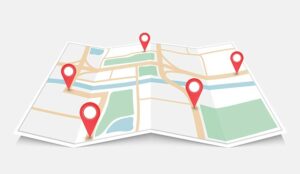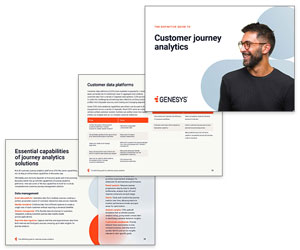Customer feedback is a vital part of customer journey mapping and improving the customer experience.
Negative feedback highlights where you need to improve and positive feedback helps to understand which elements to amplify.
We teamed up with Dan Moross, the Director of Customer Experience at MOO, to put together a guide on how you can improve the quantity and quality of feedback from your customers and how you can use it to enhance their experience with your brand.
Capturing Customer Feedback
There are four primary mechanisms that MOO uses to capture feedback from customers. These are used to help gain a better picture of the customer journey.
1. Transactional Surveys – e.g. CSAT and NPS
MOO sends out a customer satisfaction (CSAT) survey shortly after it has dealt with a customer query, achieving a response rate of nearly 30%, across live chat, phone and email.
While this is a simple format, it provides customers with the opportunity to leave a comment – to explain why they gave them a high/low score. This gives the company the opportunity to pinpoint repeat sources of dissatisfaction, while high scorers can be further engaged with, to drive a larger number of company “promoters”.
In addition to this, MOO has a company-wide Net Promoter Score (NPS), which allows it to measure satisfaction at every point of the customer journey, not just customer service interactions.
NPS is an important tool for the whole business, not just the customer service team. If NPS is only used in the contact centre, and – for example – a parcel wasn’t delivered, the customer could give the advisor a low score, even though the advisor had done a great job. This can give a distorted view of the customer journey, as it would be the logistical team who needed the feedback to make improvements.
Using a scheme like NPS champions can provide insight into which exact areas of the customer journey need the most improvement.
So, using a scheme like NPS champions can provide insight into which exact areas of the customer journey need the most improvement.
2. Voice of Employees – Customer Feedback From Your Advisors
There really is no substitute for just engaging with your team, whether that’s through focus groups or a Voice of the Employee (VoE) survey.
After all, the team don’t just handle all the contacts, they also feel the emotional burden when customers have a big problem.

MOO put great focus on listening to their frontline team
So, it is imperative to find the time to talk with advisors to understand the frequency of an issue and how much of an impact these issues have on customer emotion.
If an issue is big, but it has only affected a small number of customers, the resulting “backlash” may have had a bigger impact than you initially thought.
By taking the time to talk with the team, it is likely that you will uncover the “pain points” of your existing customer journey. These pain points are repeated areas of customer frustration.
For more on including advisors in other parts of the contact centre, read our article: Involve Agents in Operations and Strategy
3. Social Listening – via Social Media
While this isn’t something that MOO uses a lot, it is a fast-growing tool that is used by many larger organisations.
Social listening involves using technology (like Hootsuite or SproutSocial) to analyse social media to find out all the things that customers and non-customers are saying about you. This makes social listening a great device to assess the gap between what customers expect and what they perceive they get.
A customer’s perception of their experience with a brand is based on the sum of interactions with that brand across the entire customer journey, although what they expect from a brand often comes from marketing.
A customer’s perception of their experience with a brand is based on the sum of interactions with that brand across the entire customer journey, although what they expect from a brand often comes from marketing, as well as any other previous experiences that they have had with your brand.
So, it is best to close this gap as much as possible, which strengthens the case for developing strong relationships between the contact centre and the marketing department.
In fact, social listening isn’t only a useful tool for the contact centre to gain feedback, as marketing can also use it to develop offers that are based on customer demand.
4. Customer Research – Survey Panels and Interviews
The final way of gathering feedback is to talk to your customers face to face. This could be done by organising customer focus groups or arranging one-to-one interviews. MOO uses these to understand more about specific customer groups or particular aspects of the customer experience.
Another way, which we discuss further in the article “9 Ways to Encourage Customers to Give Feedback“, is to set up a customer panel. This involves asking customers who have previously chosen to give detailed feedback, both positive and negative, to join.
Once you have a panel of willing customers, you can send them a few questions each year. The volunteers would then answer these and provide their feedback.
Along with running these customer feedback initiatives, you can also be a customer yourself, to gain an unbiased view. To do this, try mystery shopping.
Along with running these customer feedback initiatives, you can also be a customer yourself, to gain an unbiased view. To do this, try mystery shopping. This will allow you to walk in their footsteps, experiencing what the customer sees first-hand, enabling you to gain an outside in perception of the journey.
Tips for Capturing More Feedback
If less than 10% of your customers are leaving feedback, as is the case for a third of contact centres, it’s hard to justify making radical changes to the customer journey on the back of that feedback.
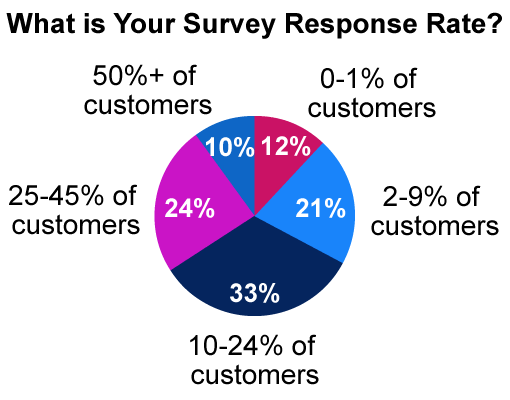
This poll is sourced from our webinar: How to Better Understand the Voice of the Customer
Here are five things that are really important to consider if you are looking to improve the rate of completion.
1. Timing Is Key
Send out your survey as close to the interaction as possible. There’s no point in sending someone a survey a month after they’ve actually completed their transaction – you want to keep it as timely as possible.
If it was a phone call, then within an hour is your “window of opportunity”. If it’s email or live chat, send the customer a link to your survey as soon as the conversation has concluded. The longer you leave it, the lower your response rate.
2. Less Is More
Don’t overload customers with questions; keep it simple. MOO only ask two questions in both CSAT and NPS surveys, helping them to keep response rates high and making it simple for their customers.
Be upfront with customers about how long it will take them to complete the survey.
Also, it’s important to be upfront with customers about how long it will take them to complete the survey. We’ve all received survey emails where it says that it will only take you three minutes and then, 25 minutes later, you’re still trying to work out how to get out of the survey – before exiting it altogether.
3. Use a Relevant Channel
It is best to use the channel that the customer used when looking to capture feedback. If someone’s ordered from your website and moved onto live chat, they probably don’t want a phone call to ask for feedback – it’s more likely that they’ll want to engage on the channel that they originated in.
So, if you are sending out a CSAT survey, for example, use the same channels where possible. If the customer was using their mobile phone, perhaps an SMS message link to a survey or a post-call IVR survey is a better option. Beware, customers will likely feel awkward giving negative feedback directly to the advisor who has served them.
4. Never Lead the Witness
Avoid asking direct questions. You want to keep them open, so that you’re giving customers the opportunity to talk about things that are important to them.
The more you drive customers to analyse a specific part of your service, the more likely you are to get feedback that wasn’t important to them.
The more you drive customers to analyse a specific part of your service, the more likely you are to get feedback that wasn’t important to them. By asking direct questions, you might take the focus away from what the customer wants to talk about.
So, keep it light and high level, and allow your customers to drive what it is they want to talk about.
5. Don’t Over-Survey
Make sure you don’t send too many surveys, as well as other sorts of communications. This can result in “customer fatigue”.
Contact centres often make the mistake of sending customers a CSAT survey, shortly followed by an NPS survey, before marketing material is sent out to that customer’s email – overloading their inbox.
Remember that it’s not only survey fatigue that you have to worry about, it’s about making sure that all of your communications on that particular channel are not bombarding the customer.
Understanding Why Your Customers Are Contacting You
Customers usually contact you because of a “pain point” along the customer journey, so feedback should be used to understand why customers are contacting you in the first place. Focusing on this will help you to improve the journey and lower contact volumes in the process.
There are a number of different ways to use customer feedback to understand why customers are contacting you, although some of them can be costly.
Low-tech: Keeping a Written Note of Popular Contact Reasons
When Dan Moross was in charge of a small contact centre team of just three or four advisors, the only way that he could keep track of repeat contact reasons was to give each advisor a pen and a piece of paper and ask them to keep track.
However, even by doing this, Dan said that he was able to spot patterns and learn which were the biggest issues that were causing customers to “bounce” into the contact centre.
Mid/Low-tech: Basic Ticket Tagging
The bigger you get, the more complex your systems might need to be. “Tagging” contacts using a simple drop-down menu is the next-simplest way to ensure that the contact centre can track issues that are ongoing.
Basic contact centre CRM systems should allow you to track these reason codes.
Mid/High-tech: Detailed Reason Categorisation of All Contacts
Another step up can be getting really detailed in your reasons by using more advanced categorisation. Larger organisations sometimes have 100+ calling codes, which are all sub-categorised into stages of the customer journey from which the customers have called.
Categorising call types can be powerful in understanding the type of contacts you’re getting, which channel you’re getting them on and whether trends are emerging or issues are dissipating.
Doing this can be powerful in understanding the type of contacts you’re getting, which channel you’re getting them on and whether trends are emerging or issues are dissipating. This enables you to see how changes you have made are impacting the customer journey and customer satisfaction.
High-tech: Voice/Text Analytics and Tagging
This technology can sort contacts into hundreds of categories, while emotion levels can be measured (through sentiment analysis) at each stage of the journey. This allows the contact centre to analyse how their service is impacting customer happiness at each customer touchpoint while still tracking why customers are entering the contact centre.
However, having real humans to supplement the technology is important, as things may get missed by surveying and tagging, so try and strike the balance between science and art.
Understanding the ENTIRE Customer Journey
The customer experience cannot be captured as a single touchpoint. That is why we’ve highlighted a number of ways for collating feedback in this article.
In order to map the entire experience, we recommend using a combination of the following, across a customer’s entire experience with your organisation:
- Customer data and metrics from the wider business (what are your CSAT, NPS and/or Customer Effort scores at each touchpoint?)
- Survey data and feedback analysis (where are your customers telling you that their pain points are?)
- Employee feedback and journey mapping sessions (where are your team telling you that your pain points are?)
- Feedback and data based on contact centre interactions (why are your customers contacting you?)
Once you’ve established your customer journey framework, i.e. noted every step that the customer takes along their journey – this Voice of the Customer (VoC) can then be used to assess customer happiness at each stage.
It’s mixing together this VoC with other customer data, from other parts of the business, which can include more commercial measures, that can give you a really nice “cauldron” of information.
Get to the Root of Your Problems
Using a combination of this VoC and customer journey mapping allows you to get to the root of many contact centre problems.
MOO runs frequent customer journey mapping sessions, where they take advisors away from the frontline and map out different customer journeys, for a different type of customer, while trying to pinpoint moments that matter in that customer experience. Often these moments closely correlate with survey feedback or customer data. The company then target these as areas to improve service.
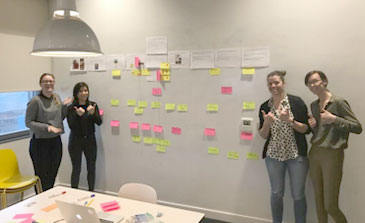
MOO like to involve the team in journey mapping exercises
In these “moments that matter”, it’s important to focus on the processes, people and technology that are involved and try to devise new solutions or “wow” moments that can be implemented to improve service.
In these “moments that matter”, it’s important to focus on the processes, people and technology that are involved and try to devise new solutions or “wow” moments.
Sometimes there will be an opportunity for a large-scale change, which may be outside the control of the contact centre team, but MOO has continually rolled out smaller, marginal gains that make a cumulative impact. So, try to design little solutions that can be implemented quickly to make little wins.
Involve the Whole Organisation in Journey Mapping
In each customer journey session that MOO runs, it involves at least four or five customer-facing employees and a few people from other teams in the business.
It engages frontline staff, helping them to see the bigger picture, understanding all the things that go on behind the scenes. This allows you to get a really broad view of how everything works.
In addition, by involving each part of the business in customer journey mapping, you can work to improve every single touchpoint of the customer journey. You also open up more possibilities for “wow” moments if different sectors of the business can successfully work together.
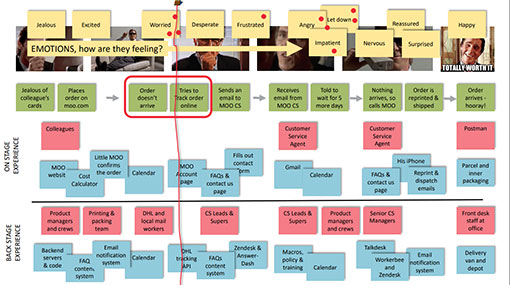
Above is an example of a MOO customer journey map, which was generated from a contact centre session in 2017. In this example, MOO have used the persona of Patrick Bateman to try and track his experience when placing an order with the company.
For more on using customer personas when journey mapping, read our article: 6 Ideas for Customer Journey Mapping
Different Ways to Improve the Experience
The chief goal in taking all of this customer feedback and then doing these customer journey mapping sessions is to try and drive smaller marginal gains in the contact centre.
Designing new solutions doesn’t have to involve grandiose development plans and company-wide initiatives. MOO’s Customer Experience team is focused on driving marginal gains in the contact centre, as well as campaigning for larger cross-functional initiatives.
Examples of success from MOO’s contact centre, derived from this feedback and mapping process, include:
Proactive Notifications and Reach-Outs
If MOO can predict a customer having to get in touch with them, they reach out to the customer before it happens, sending a proactive notification. Late-shipment notifications were added to their day-to-day operation as a result of journey mapping, helping to improve the experience and reducing call volumes.
Content Improvements
MOO uses journey mapping to look for ideas in improving its self-service content at appropriate points in the journey too. As a result of their contact centre journey mapping, they identified countless new articles to add and helped customers to resolve their own issues.
Yet it’s not all about self-service. In terms of content improvement, MOO also looks at other ways the contact centre can provide better options, reducing the need to call. Creating “How to” videos is one way they achieve this.
Training and Policy Changes
Don’t forget the simple things. For example: is there a bit of missing training here? Or is there “loose knowledge”, meaning when a particular problem does occur, the contact centre is not dealing with it in the best way?

Dan Moross
Also, think about your contact centre policies. Are they preventing advisors from giving the best possible service? This could be policies like refusing refunds or targeting advisors on Average Handling Time (AHT).
While the contact centre won’t save millions of pounds by making these sorts of fixes, the goal is that cumulatively the contact centre will be mending small parts of the customer experience and creating happier customers.
For more on the topic of customer journey mapping: 5 Steps to Creating a Customer Journey Map
Thanks to Dan Moross from MOO for helping to put this article together.
For more from MOO’s contact centre, read our article: 19 Things We Learnt at the MOO Contact Centre
Author: Robyn Coppell
Published On: 26th Jun 2018 - Last modified: 14th Aug 2025
Read more about - Customer Service Strategy, Customer Feedback, Customer Journey, Service Strategy










